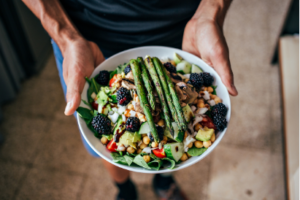The Paleo diet, inspired by the dietary habits of our hunter-gatherer ancestors, has gained wide spread popularity for its emphasis on whole, un processed foods. While the diet focuses on quality over quantity, tracking your calories can be a game-changer in achieving faster and more sustainable results. Whether you aim to lose weight, build muscle, or improve overall health, understanding your caloric intake within the Paleo frame work can help you optimize your efforts.
In this article, we’ll explore why track your paleo calories diet is beneficial, how to do it effectively, and practical tips to make the process seamless.
Why Tracking Calories on a Paleo Diet Matters
1. Understanding Energy Balance

At its core, weight management boils down to energy balance:
- Caloric deficit: Consuming fewer calories than you burn leads to weight loss.
- Caloric surplus: Eating more calories than you burn promotes weight gain.
Even with nutrient-dense foods, overeating can hinder your goals. Tracking calories ensures you’re aligned with your energy needs while adhering to Paleo principles.
2. Avoiding Common Paleo Pitfalls

While the Paleo diet emphasizes healthy, whole foods, some common pitfalls can arise:
- Overeating calorie-dense foods: Nuts, seeds, and natural sweeteners like honey can quickly add up.
- Underestimating portions: Without portion control, even nutrient-dense foods can lead to excess calorie consumption.
By tracking your intake, you can pinpoint areas where adjustments are needed.
3. Customizing Your Approach

Every individual’s caloric needs vary based on age, gender, activity level, and goals. Tracking helps tailor your Paleo diet to your unique requirements, ensuring optimal results.
How to Track Calories on a Paleo Diet
1. Determine Your Caloric Needs
Start by calculating your Total Daily Energy Expenditure (TDEE). This value represents the number of calories you burn daily, including:
- Basal Metabolic Rate (BMR): Calories burned at rest.
- Activity Level: Calories burned through exercise and daily activities.
Use an online TDEE calculator and adjust your intake based on your goals:
- For weight loss: Subtract 500-750 calories from your TDEE.
- For muscle gain: Add 250-500 calories to your TDEE.
2. Choose a Tracking Tool
Several apps and tools can help you track your calories and macros:
- MyFitnessPal: Allows custom food entries for Paleo-specific items.
- Cronometer: Focuses on micronutrients and whole-food tracking.
- Carb Manager: Ideal for those monitoring carb intake on Paleo.
Ensure the tool you choose accommodates Paleo-friendly foods.
3. Weigh and Measure Your Food
Accuracy is key when tracking calories. Invest in a digital kitchen scale to measure portions of:
- Protein sources (e.g., grass-fed beef, wild-caught fish, eggs).
- Vegetables and fruits.
- High-calorie items like nuts and oils.
4. Log Your Meals
Record everything you eat and drink. Be mindful of:
- Hidden calories: Cooking oils, sauces, and dressings.
- Snacks: Even small handfuls of nuts can add up.
Tips for Successful Calorie Tracking on Paleo
1. Focus on Nutrient Density
Prioritize foods that provide the most nutrients per calorie, such as:
- Leafy greens (spinach, kale).
- Lean proteins (chicken breast, turkey).
- Healthy fats (avocado, coconut oil).
2. Meal Prep for Accuracy
Preparing meals in advance makes portion control and tracking easier. Use meal prep containers to store pre-measured portions of proteins, vegetables, and healthy fats.
3. Be Mindful of Liquid Calories
Beverages like kombucha, coconut water, or Paleo-approved smoothies can contain hidden calories. Always track these to stay within your caloric range.
4. Allow Flexibility
While precision is essential, avoid becoming overly rigid. Occasional untracked meals won’t derail your progress if consistency is maintained over time.
Common Questions About Tracking Calories on Paleo
1. Is tracking calories necessary on Paleo?
While not mandatory, tracking calories can help you:
- Identify overeating habits.
- Stay accountable to your goals.
- Understand portion sizes better.
2. How do I track calories for homemade Paleo meals?
Use a food scale and recipe calculator (e.g., MyFitnessPal’s recipe feature) to determine the caloric content of your meals.
3. What if I’m following Paleo for health rather than weight loss?
Even if weight loss isn’t your goal, tracking calories can ensure you’re meeting your nutritional needs and avoiding deficiencies.
Benefits of Tracking Calories on Paleo
1. Improved Awareness
Tracking helps you understand how much you’re eating and whether your portions align with your goals.
2. Enhanced Accountability
Logging your meals fosters consistency and discipline, key factors for long-term success.
3. Faster Results
By aligning your caloric intake with your goals, you’ll likely see quicker progress in weight loss, muscle gain, or improved health markers.
Conclusion
Tracking your calories on a Paleo diet can be a powerful tool for achieving your health and fitness goals faster. By understanding your caloric needs, using the right tools, and staying consistent, you’ll gain better control over your progress while enjoying the benefits of a nutrient-dense diet.
Ready to take your Paleo journey to the next level? Start tracking today and unlock your full potential!

